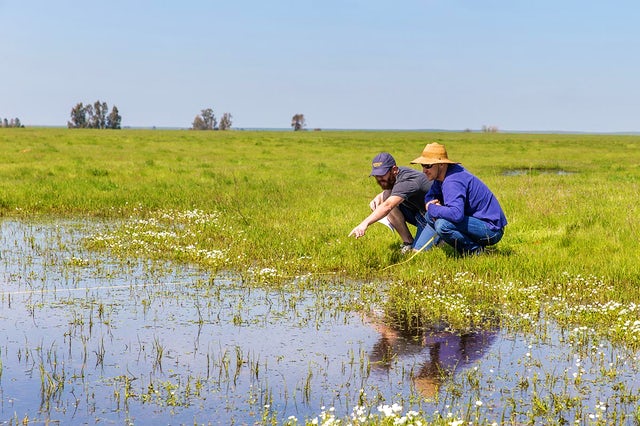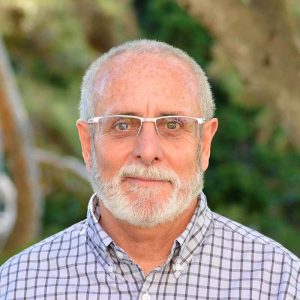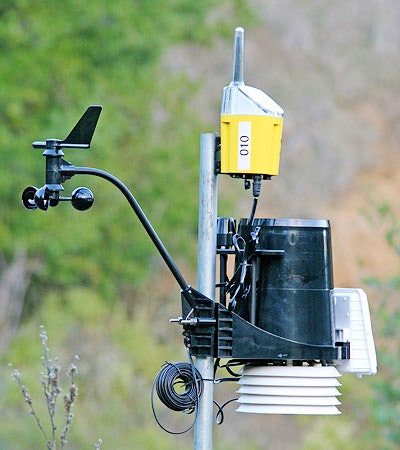In an effort to improve water management, the University of California will install sensor networks across various protected habitats to predict how freshwater moves, biology professor Todd Dawson explains.

Researchers at Merced Vernal Pools and Grassland Reserve, one of many research sites owned by the University of California
CALIFORNIA IS ABOUT to learn a whole lot more about how water moves through its many diverse landscapes.
The Gordon and Betty Moore Foundation has awarded a $2.2 million grant to the University of California to use remote sensors and drones to monitor hydrology across various landscapes. The subject areas will be the U.C.’s Natural Reserve System, a network of protected lands covering more than 750,000 acres and representing many habitat types in the state.
Called the California Heartbeat Initiative-Freshwater, the project will equip reserves with wireless sensor nodes to track weather, soil moisture, transpiration and a host of other criteria. Each node, about the size of a thermos, is outfitted with a battery and solar panel. They communicate wirelessly with each other and a central computer. Drones will fly programmed routes with special cameras attached to monitor how vegetation changes with the climate.
The overarching goal is to link the wealth of data from the sensors with climate shifts. Ultimately, this will help create finer-grained climate models to predict how landscapes might change in the future. If this can be expanded across the state, it could help officials plan ways to reduce the impact of drought and other stressors on habitats, agriculture and urban environments.
To learn more about the project, Water Deeply recently interviewed Todd Dawson, the lead investigator and a biology professor at U.C. Berkeley.
Water Deeply: What’s unique about this study? Is it a first?
Todd Dawson: There are a few things that may be unique about it. It’s really trying to apply some of the more recent technology innovations, like the use of wireless sensor networks and use of drones, for example, and the different kinds of cameras that drones can use now to basically look back down at Earth. It’s taking those innovations and sort of applying them in ways that they’ve never been applied before.

Professor Todd Dawson is the lead investigator at the California Heartbeat Initiative-Freshwater and a biology professor at U.C. Berkeley.
In that regard, the way they’re being applied is to really try to look at how aspects of the Earth’s surface are changing, and in particular, changing with respect to how water is flowing across that landscape or going into or out of that landscape. The critical theme here is all about freshwater. But then it’s trying to say, how do we look at freshwater in and on the landscape, in the vegetation, in the wildlife – things like that – using this new set of tools that we have.
Water Deeply: Can you describe the study sites? Many people aren’t familiar with the U.C.’s Natural Reserve System.
Dawson: The Natural Reserve System basically started just over 50 years ago. Now there are 40 natural reserves spread throughout the entire state of California. They range in size from really small to quite large – tens of thousands of acres.
They cover basically the broad spectrum of different natural ecosystems that our state possesses, everything from desert to forest, high elevation, right near the seashore, you name it. It really represents the diversity of natural resources that our state has.
Water Deeply: Tell me more about these ‘next generation’ sensors you are using.
Dawson: With monitoring climate change, many times we have a single meteorological station at a site. Basically it’s making a set of measurements at one place. And it doesn’t tell you anything about the variation in that place.
So one of the technologies we’re applying is this wireless sensor network that allows us to extend the footprint of all those climate measurements to cover more of the variation in a particular place: north and south slopes, high and low elevation, down a stream corridor, the top of a tree. You name it. They’re self contained, they have a little battery inside and a little solar panel, and then you basically can customize the sensors you put in them to meet the scientific objectives that you have. So if you are interested in the soil environment, you can hook up a whole bunch of different soil sensors – moisture, temperature, etc. They can be tailored and customized to the particular investigator’s needs.

An example of a wireless sensor node of the sort that will be installed at many of the University of California’s Natural Reserve System properties to track hydrology, weather, vegetation and soil.
We can basically deploy those wireless sensors pretty much anywhere you want to quantify the things researchers would really like to know more about: temperature, light, soil moisture. And because it’s wireless and everything, the data flow back to a base station, and it basically uses self-organizing algorithms.
Water Deeply: And how will drones be used?
Dawson: The drone is allowing us to get above the land surface and look back down at that land surface with a whole new suite of different kinds of cameras. Those cameras also have some sensors associated with them, such as thermal infrared sensors. So we can not just take pictures from a drone, but we can use these new kinds of cameras which they call multispectral cameras. They allow you to look at different colors of the spectrum and also look at thermal.
You can basically extract information from the air that you would otherwise find really challenging to collect, because you would have to walk out and make all those measurements by foot on the landscape. Now we can just fly a drone over the top of them. So we can map the vegetation on an entire site in an afternoon. Then if we do that over time, we get change detections. We can see how the vegetation is changing from the wet season through the dry season. Or if there was a fire that sweeps through an area.
Water Deeply: A major goal of this project is documenting how water moves through landscapes. Can you explain?
Dawson: We want to come to a better understanding of our freshwater resources here in the state of California. We can look at the major rivers, things that are gaged, and things the California Water Resources Control Board measures easily. We know lot about those. But those are usually just all the big rivers. Not really all the small streams or the tributaries or things that are out there in the landscapes that few people ever visit.
So one of the opportunities here is to take the natural reserves, and the monitoring of the water resources at those reserves, as a way to enhance our understanding about California’s natural water resources and how they vary in space and time. For example, we had this big drought we went through that ended in 2016. Over 100 million trees died in it. If we had a better understanding about what those trees were doing in relation to the water resources out there – like the snowpack or runoff, what’s in the soil and groundwater – we might have had a better feeling for where those forests were going to be impacted.
The Moore Foundation provided us with three years of initial funding. But they have said, depending on the kind of progress we make, there may be some continuing funding that could be applied. But we kind of have to prove the concept first.
Water Deeply: There’s also a connection to climate change, right?
Dawson: One of the goals is that if we have more fine-detailed monitoring with these wireless sensor networks, and we are mindful of the water resources, we’ll be able to see whether a particular trajectory of climatic variation across these different sites can be linked to changes in the water resources as well, things like drought. If we’re really able to tell, say, now we’re entering a time where droughts are going to become more frequent, that clearly is going to have impacts on water resources, forests and other natural resources but also for agricultural resources and urban environments, too. We’re going to be able to see how closely those things are linked together.
Source: https://www.newsdeeply.com/
Dear User/Visitor! Please, answer on our questions: tick off one of the positions – your answer will make us able to improve our site and make it more interesting and useful!

